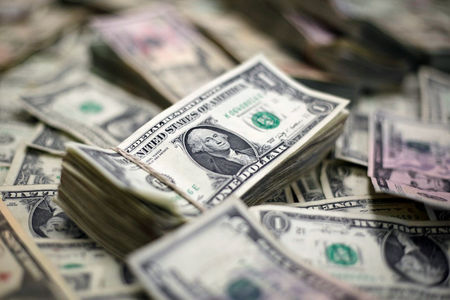Forex
Asia FX dips, dollar near 6-mth peak before Fed, c.bank-heavy week


© Reuters.
Investing.com– Most Asian currencies fell on Monday, while the dollar steadied near six-month highs as markets hunkered down before several key central bank rate decisions this week, most notably the Federal Reserve.
Lingering concerns over China, particularly the country’s struggling property market, also kept broader sentiment subdued. Chinese police detained some employees of embattled developer China Evergrande Group (HK:), sparking concerns over renewed regulatory scrutiny towards the sector.
The fell 0.2%, shrugging off a stronger daily midpoint fix by the People’s Bank of China (PBOC). The PBOC is expected to keep its at record lows this Wednesday, as it struggles to meet a balance between supporting economic growth and stemming more yuan weakness.
The dollar retained most of its recent strength, staying within sight of a six-month peak hit last week as investors positioned for more signals from the Fed. The and fell less than 0.1% each in Asian trade.
Concerns over a U.S. government shutdown, amid disagreements over defence spending between major Republican lawmakers, also kept markets on edge.
Fed expected to pause, but rising inflation muddles rate outlook
The U.S. central bank is widely expected to hold interest rates at the on Wednesday.
But the Fed is widely expected to maintain its hawkish stance, as rising oil prices fueled a resurgence in inflation over the past two months. The trend could elicit at least one more hike from the bank this year, and is also expected to give the bank more impetus to keep .
“Inflation concerns linger and economic resilience suggest the Fed will continue to signal the potential for a final hike even if we don’t think it carry through with it,” analysts at ING wrote in a note.
Asian markets are likely to see continued pressure on the prospect of higher interest rates, with a rate cut only expected by mid-2024, before the Presidential elections.
While regional trading volumes were muted on account of a Japanese market holiday on Monday, some weak economic data also weighed on Asian sentiment. The fell slightly as data showed the country’s – a bellwether for Southeast Asian trade- fell more than expected in August.
The firmed slightly as Michele Bullock took over as governor of the Reserve Bank of Australia.
BOJ pivot in focus, yen near 10-month low
The moved little in holiday trade on Monday, but was trading just above its weakest level since November 2022.
Markets are largely focused on a this Friday, amid some signals from top officials that the bank was considering a pivot away from its negative rate regime.
Sticky inflation and increasing Japanese wages furthered this notion, with BOJ Governor Kazuo Ueda signaling that nearly a decade of negative interest rates had now provided sufficient levels of stimulus to the economy.
While any rate increases are likely to provide some support to the yen, the currency is still struggling amid declining carry trade interest and a widening gulf between local and U.S. interest rates.

 Forex3 years ago
Forex3 years agoForex Today: the dollar is gaining strength amid gloomy sentiment at the start of the Fed’s week

 Forex3 years ago
Forex3 years agoUnbiased review of Pocket Option broker

 Forex3 years ago
Forex3 years agoDollar to pound sterling exchange rate today: Pound plummeted to its lowest since 1985

 Forex3 years ago
Forex3 years agoHow is the Australian dollar doing today?

 Cryptocurrency3 years ago
Cryptocurrency3 years agoWhat happened in the crypto market – current events today

 World3 years ago
World3 years agoWhy are modern video games an art form?

 Commodities3 years ago
Commodities3 years agoCopper continues to fall in price on expectations of lower demand in China

 Economy3 years ago
Economy3 years agoCrude oil tankers double in price due to EU anti-Russian sanctions





















